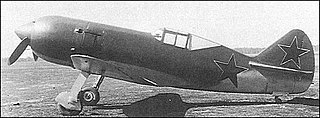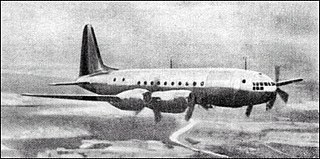Development
After the end of World War II the GVF (Grazdahnskij Vozdushnyj Flot–Civil Air Fleet) issued a requirement for a passenger aircraft to service low-volume destinations too small to justify a Lisunov Li-2. It wanted an aircraft capable of carrying ten passengers over a distance of 800 km (500 mi) at a cruising speed of 290 km/h (180 mph) that would be powered by a pair of 700-horsepower (520 kW) Shvetsov ASh-21 radial engines. The Yakovlev OKB was tasked to fulfill this requirement in February 1946 with the first prototype ready for State acceptance trials on 1 November 1946. [2] This proved to be too optimistic considering the amount of work the OKB was already doing and this was delayed to August 1947. The specification was revised at the same time to specify a speed no less than 350 km (220 mi) at sea level and that the military version was to mount a dorsal turret with a single 20 mm (0.79 in) gun. [3]
The Yak-16 was a low-winged, twin-engined monoplane that closely resembled the Li-2. The metal-skinned, semi-monocoque fuselage had room for a two-person cockpit and ten passengers plus a toilet and baggage hold. The control surfaces of the tail were fabric-covered although the tail itself was metal-skinned. The two-spar metal wing was built in three sections, a rectangular center section and two trapezoidal outer panels. The main undercarriage legs retracted forward into the engine nacelles, with the wheels remaining semi-exposed, while the tailwheel was fixed. The ASh-21 engines had NACA cowlings and drove two-bladed variable-pitch VISh-11V-20 propellers. [4]
The first prototype, often referred to as the Yak-16-I, made its first flight on 24 September 1947 and proved to have excellent handling characteristics with one engine out and could also climb with one engine inoperable. It passed its State acceptance trials in early 1948 at the NII GVF (Nauchno-Issledovatel'skiy Institut Grazhdanskogo Vozdushnogo Flota—Scientific Test Institute for Civil Air Fleet). [5]
The military transport version, often called the Yak-16-II, differed from the passenger version as it carried a UTK-1 ball turret that mounted a 12.7 mm (0.50 in) Berezin UBT machine gun immediately behind the flight deck, the cargo cabin floor was reinforced, the vertical tail was slightly larger and the fuselage was slightly longer. It used three-bladed V-511 feathering propellers with scimitar-shaped blades. It could carry seven paratroopers, ten fully equipped troops or six stretcher cases and a medical attendant. It was fitted with a large clamshell door on the left side of the fuselage to facilitate cargo loading. This door had a smaller, inward-opening door set into its forward half. Three TsDMMM-120 supply containers could be fitted on racks underneath the wing center section and it was fitted with a glider tow hook. [6]
The Yak-16-II passed its manufacturer's trials in April 1948 and was submitted for the State acceptance trials shortly afterwards. These revealed several deficiencies that caused the horizontal tail area to be increased and deicing equipment to be fitted on the leading edges of the wings and tail. It was resubmitted for another round of State acceptance trials which approved it for production. However, it was not selected for production as the Antonov An-2 was thought to be more versatile in both roles. Some effort was made to drum up export sales in Eastern Europe, but no interest was shown because it was not in service with Aeroflot. The prototypes were used for a time by the Yakovlev OKB and Factory No. 464 which had built them. [7]

The Mikoyan-Gurevich I-250, aka MiG-13, was a Soviet fighter aircraft developed as part of a crash program in 1944 to develop a high-performance fighter to counter German turbojet-powered aircraft such as the Messerschmitt Me 262. The Mikoyan-Gurevich design bureau decided to focus on a design that used something more mature than the jet engine, which was still at an experimental stage in the Soviet Union, and chose a mixed-power solution with the VRDK motorjet powered by the Klimov VK-107 V12 engine. While quite successful when it worked, with a maximum speed of 820 km/h (510 mph) being reached during trials, production problems with the VRDK fatally delayed the program and it was canceled in 1948 as obsolete.
The Tupolev Tu-75 was a military transport variant of the Tu-4 bomber, an unlicensed, reverse engineered copy of the Boeing B-29 Superfortress. The Tu-75 was similar to the Tu-70 airliner, both using a new, purpose-designed fuselage. The first Soviet military machine of this class, it was equipped with a rear fuselage loading ramp. It was not placed into production because the VVS decided it would be cheaper to modify its existing Tu-4s for the transport mission and to use its existing Lisunov Li-2 and Ilyushin Il-12 transports.
The Tupolev Tu-70 was a Soviet passenger variant of the Tu-4 bomber, an unlicensed, reverse engineered copy of the Boeing B-29 Superfortress. Designed immediately after the end of World War II, it used a number of components from Boeing B-29s that had made emergency landings in the Soviet Union after bombing Japan. It had the first pressurized fuselage in the Soviet Union and first flew on 27 November 1946. The aircraft was successfully tested, recommended for serial production, but ultimately not produced because of more pressing military orders and because Aeroflot had no requirement for such an aircraft. A military cargo aircraft version was the Tupolev Tu-75.

The Yakovlev Yak-12 is a light multirole STOL aircraft used by the Soviet Air Force, Soviet civilian aviation and other countries from 1947 onwards.

The Yakovlev Yak-15 is a first-generation Soviet turbojet fighter developed by the Yakovlev design bureau (OKB) immediately after World War II. The main fuselage was that of Yakovlev Yak-3 piston-engine fighter modified to mount a reverse-engineered German Junkers Jumo 004 engine. The Yak-15 and the Swedish Saab 21R were the only two jets to be successfully converted from piston-power to enter production. 280 aircraft were built in 1947. Although nominally a fighter, it was mainly used to qualify piston-engine-experienced pilots to fly jets.

The Yakovlev Yak-30 was an experimental Soviet interceptor from the late 1940s. Derived from the Yak-25, from which it differed primarily in having wings sweptback 35° at quarter chord, the Yak-30 retained the fuselage, tail surfaces and undercarriage of the earlier fighter.

The Yakovlev Yak-6 was a Soviet twin-engined utility aircraft, developed and built during World War II. It was used as a short-range light night bomber and a light transport.

The Mikoyan-Gurevich I-211 was a prototype high-altitude Soviet fighter aircraft built during World War II. It was a version of the Mikoyan-Gurevich I-210, itself a variant of the Mikoyan-Gurevich MiG-3, fitted with a Shvetsov ASh-82F radial engine. Its development was quite prolonged, although successful, but by the time it finished its manufacturer's trials in early 1944 there was no need for a high-altitude fighter and it was not worth reducing the production of existing fighters to convert a factory over to the I-211.

The Yakovlev EG (Eksperimentalnyi Gelikopter), also commonly known as the Yak-M11FR-1 and Sh (Shootka), was an experimental aircraft with coaxial rotors. The prototype was first flown by V.V. Tezavrovsky in December 1947.
The Yakovlev Yak-20 was an experimental piston-engined trainer developed in the Soviet Union in 1949. It did not go into production.
The Yakovlev Yak-58 is a small, multi-role utility transport and business aircraft. The aircraft features a pusher engine and twin boom tail. It saw limited production in the late 1990s.
The Yakovlev Yak-5 was an experimental trainer aircraft designed by Yakovlev OKB in the Soviet Union, and first flown in 1944.

The Ilyushin Il-18 was a Soviet four-engined airliner designed and built by Ilyushin immediately after World War II. Although the aircraft itself was successful, its Shvetsov ASh-73TK engines were too unreliable for civilian use and were further needed to equip the Tupolev Tu-4 bomber, so it was cancelled in 1948.

The Yakovlev Yak-8 was a Soviet utility aircraft developed during World War II. It was not accepted for production, but received the NATO reporting name "Crib" anyway.

The Yakovlev Yak-200 was a prototype Soviet multi-engine trainer built during the 1950s. A modified version was built as the Yak-210 for navigator training, but only one example of each was built before the program was cancelled in 1956.
The Yakovlev AIR-6 was a Soviet light utility aircraft of the 1930s. It was a single-engined high-wing monoplane designed by Alexander Sergeyevich Yakovlev, with 128 being built.

The Yakovlev AIR-7 was a prototype Soviet high performance light aircraft of the 1930s. It was a two-seat single-engined monoplane, which demonstrated excellent performance during testing. After the prototype almost crashed as a result of flutter, its designer, Alexander Sergeyevich Yakovlev suffered temporary disgrace and no production followed.
The Yakovlev Ya-19,, was a 5-seat light transport aircraft developed directly from the Yakovlev UT-3 during the late 1930s. The Ya-19 did not enter production, despite positive results from flight trials, due to the lack of development of the UT-3 and cancellation of the Voronezh MV-6 engine program, which were the result of changing priorities in the face of the Great Patriotic War.

TheYakovlev AIR-9 / AIR-9bis was a 2-seat sport aircraft designed and built in the USSR during the early 1930s.
The Yakovlev AIR-12 was a long-range sport aircraft designed and built in the Soviet Union during the late 1930s.












